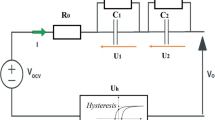Abstract
For safe and reliable operation of lithium-ion batteries in electric vehicles, the real-time monitoring of their internal states is important. The purpose of our study is to find an easily implementable, online identification method for lithium-ion batteries in electric vehicles. In this article, we propose an equivalent circuit model structure. Based on the model structure we derive the recursive mathematical description. The recursive extended least square algorithm is introduced to estimate the model parameters online. The accuracy and robustness are validated through experiments and simulations. Real-road driving cycle experiment shows that the proposed online identification method can achieve acceptable accuracy with the maximum error of less than 5.52%. In addition, it is proved that the proposed method can also be used to estimate the real-time SOH and SOC of the batteries.
Similar content being viewed by others
References
Hou X, Hu S. First principles studies on the electronics structures of (Li1−xMex)FePO4 (Me=Na and Be). Chin Sci Bull, 2010, 55: 3222–3227
Smith K A, Rahn C D, Wang C Y. Control oriented id electrochemical model of lithium ion battery. Energ Convers Manag, 2007, 48: 2565–2578
Lee J L, Chemistruck A, Plett G L. One-dimensional physics-based reduced-order model of lithium-ion dynamics. J Power Sources, 2012, 220: 430–448
Wang L, Xu Z, Yang S, et al. Real-time in situ tem studying the fading mechanism of tin dioxide nanowire electrodes in lithium ion batteries. Sci China Tech Sci, 2013, 56: 2630–2635
Yang K, An J, Chen S. Thermal behavior analysis of nickel/metal hydride battery during overcharging. Sci China Chem, 2010, 53: 1177–1182
Hausmann A, Depcik C. Expanding the Peukert equation for battery capacity modeling through inclusion of a temperature dependency. J Power Sources, 2013, 235: 148–158
Liaw B Y, Roth E P, Jungst R G, et al. Correlation of Arrhenius behaviors in power and capacity fades with cell impedance and heat generation in cylindrical lithium-ion cells. J Power Sources, 2003, 119: 874–886
Xu L, Wang J P, Chen Q S. Kalman filtering state of charge estimation for battery management system based on a stochastic fuzzy neural network battery model. Energ Convers Manag, 2012, 53: 33–39
Li S G, Sharkh S M, Walsh F C, et al. Energy and battery management of a plug-in series hybrid electric vehicle using fuzzy logic. IEEE T Veh Technol, 2011, 60: 3571–3585
Pattipati B, Sankavaram C, Pattipati K R. System identification and estimation framework for pivotal automotive battery management system characteristics. IEEE T Syst Man Cy C, 2011, 41: 869–884
Dai H F, Wei X Z, Sun Z C, et al. Online cell SOC estimation of li-ion battery packs using a dual time-scale Kalman filtering for EV applications. Appl Energ, 2012, 95: 227–237
He H W, Xiong R, Guo H Q. Online estimation of model parameters and state-of-charge of LiFePO4 batteries in electric vehicles. Appl Energ, 2012, 89: 413–420
Zhuang Q, Xu J, Fan X, et al. LiCoO2 electrode/electrolyte interface of li-ion batteries investigated by electrochemical impedance spectroscopy. Sci China Ser B: Chem, 2007, 50: 776–783
Gould C R, Bingham C M, Stone D A, et al. New battery model and state-of-health determination through subspace parameter estimation and state-observer techniques. IEEE T Veh Technol, 2009, 58: 3905–3916
He H W, Xiong R, Zhang X W, et al. State-of-charge estimation of the lithium-ion battery using an adaptive extended Kalman filter based on an improved Thevenin model. IEEE T Vehr Technol, 2011, 60: 1461–1469
Chen Z, Mi C C, Fu Y H, et al. Online battery state of health estimation based on genetic algorithm for electric and hybrid vehicle applications. J Power Sources, 2013, 240: 184–192
Chu F, Wang F, Wang X, et al. A model for parameter estimation of multistage centrifugal compressor and compressor performance analysis using genetic algorithm. Sci China Tech Sci, 2012, 55: 3163–3175
Prasad G K, Rahn C D. Model based identification of aging parameters in lithium ion batteries. J Power Sources, 2013, 232: 79–85
Yang W Y. Signals and Systems with Matlab. Heidelberg: Spriner-Verlag, 2009. 280–288
U.S. Environmental Protection Agency. EPA Urban Dynamomet Driving Schedule. http://www.epa.gov/oms/standards/light-duty/udds.htm.
Magdi S M, Xia Y Q. Applied Control Systems Design. London: Spriner-Verlag, 2012. 248–250
Hu X S, Sun F C, Zou Y. Online model identification of lithium-ion battery for electric vehicles. J Central South Univ Technol, 2011, 18: 1525–1531
Gould C R, Bingham C M, Stone D A, et al. Novel battery model of an all-electric personal rapid transit vehicle to determine state-of-health through subspace parameter estimation and a Kalman estimator. In: Proceedings of the 2008 International Symposium on Power Electronics, Electrical Drives, Automation and Motion. Ischia, 2008. 1217–1222
Broussely M, Biensan P, Bonhomme F, et al. Main aging mechanisms in Li-ion batteries. J Power Sources, 2005, 146: 90–96
Ramadass P, Haran B, White R, et al. Mathematical modeling of the capacity fade of Li-ion cells. J Power Sources, 2003, 123: 230–240
Zhang F, Liu G J, Fang L J, et al. Estimation of battery state of charge with H-infinity observer: applied to a robot for inspecting power transmission lines. IEEE T Ind Electron, 2012, 59: 1086–1095
Plett G L. Sigma-point Kalman filtering for battery management systems of LiPB-based HEV battery packs-part 2: Simultaneous state and parameter estimation. J Power Sources, 2006, 161: 1369–1384
Author information
Authors and Affiliations
Corresponding author
Rights and permissions
About this article
Cite this article
Li, Y., Wang, L., Liao, C. et al. Recursive modeling and online identification of lithium-ion batteries for electric vehicle applications. Sci. China Technol. Sci. 57, 403–413 (2014). https://doi.org/10.1007/s11431-013-5431-y
Received:
Accepted:
Published:
Issue Date:
DOI: https://doi.org/10.1007/s11431-013-5431-y




